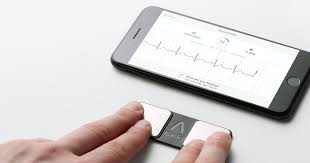
Newswise — Can your smartphone determine if you’re having the most serious – and deadly – form of heart attack? A new research study says it can – and may be a valuable tool to save lives.
The international study, led by researchers from the Intermountain Medical Center Heart Institute in Salt Lake City, found that a smartphone app to monitor heart activity and determine if someone is having an ST-Elevation Myocardial Infarction (STEMI), a heart attack in which the artery is completely blocked, has nearly the same accuracy as a standard 12-lead electrocardiogram (ECG), which is used to diagnose heart attacks.
Researchers say the findings are significant because the speed of treatment after a STEMI heart attack helps save lives.
“The sooner you can get the artery open, the better the patient is going to do. We found this app may dramatically speed things up and save your life,” said J. Brent Muhlestein, MD, lead investigator of the study and cardiovascular researcher at the Intermountain Medical Center Heart Institute.
In the study, 204 patients with chest pain received both a standard 12-lead ECG and an ECG through the AliveCor app, which is administered through a smartphone with a two-wire attachment. Researchers found the app with the wire set-up effective in distinguishing STEMI from not-STEMI ECGs accurately and with high sensitivity compared to a traditional 12-lead ECG.
“We found the app helped us diagnose heart attacks very effectively — and it didn’t indicate the presence of a heart attack when one wasn’t occurring,” Dr. Muhlestein said.
A STEMI is a very serious type of heart attack during which one of the heart’s major arteries — which supplies oxygen and nutrient-rich blood to the heart muscle — is blocked. ST-segment elevation is an abnormality that’s detectable on the 12-lead ECG.
Researchers presented results from the study at the American Heart Association’s 2018 Scientific Session in Chicago.
Researchers conducted the study, called the ST LEUIS International Multicenter Study, at five international sites that are all associated with the Duke University Cooperative Cardiovascular Society (DUCCS), with Intermountain Medical Center Heart Institute serving as the coordinating institution where they collected and collated data.
Other participating research centers include: Duke University, Integris Heart Hospital (Oklahoma City), Catholic University (Argentina), Mayo Clinic, Stanford University, Erlanger Institute for Clinical Research (Tennessee), University of Utah Health, AliveCor Corporation, and the Rocky Mountain University of Health Professions.
The idea for this kind of ECG set-up perhaps came from the use of treadmills for personal fitness development, said Dr. Muhlestein. Many people using treadmills wear a simple device that can detect their heart rate, through a single ECG lead, more accurate than just checking the pulse. “It’s a simple jump from there to putting it on a smartphone, and then recording the same ECG lead from several body positions.” he said.
The new Apple 4 smartwatch also comes with a single-lead ECG. A typical ECG has 12 leads, which improves the accuracy of a diagnosis because heart attacks happen in different parts of the heart, and each lead looks at a different part. With the AliveCor app, the two wire leads are moved around the body in order to record all 12 parts.
The findings of the study are important for two reasons, said Dr. Muhlestein.
The first is it could speed up the urgent treatment a patient needs after suffering a STEMI. American College of Cardiology/American Heart Association guidelines recommend that the “door-to-balloon time” – or the time from when a patient enters the hospital to when a catheter with a balloon on the tip is inserted into the patient’s blocked artery, then inflated to flatten plaque against the wall of the artery – be less than 90 minutes.
“If somebody gets chest pain and they haven’t ever had chest pain before, they might think it’s just a bug or it’s gas and they won’t go to the emergency room,” Dr. Muhlestein said. “That’s dangerous, because the faster we open the blocked artery, the better the patient’s outcome will be.”
The app can take the electrocardiogram on the spot, send the results into the cloud where a cardiologist reviews it immediately and, if a STEMI is found, tell the person so they can be rushed to the hospital.
Secondly, the price of the app with the two-wire extension is low, which could put the power of an ECG into the hands of anyone with a smartphone or smartwatch, and make ECGs accessible in places like third world countries where people have smartphones but where expensive ECG machines are hard to find, if they’re available at all.





































